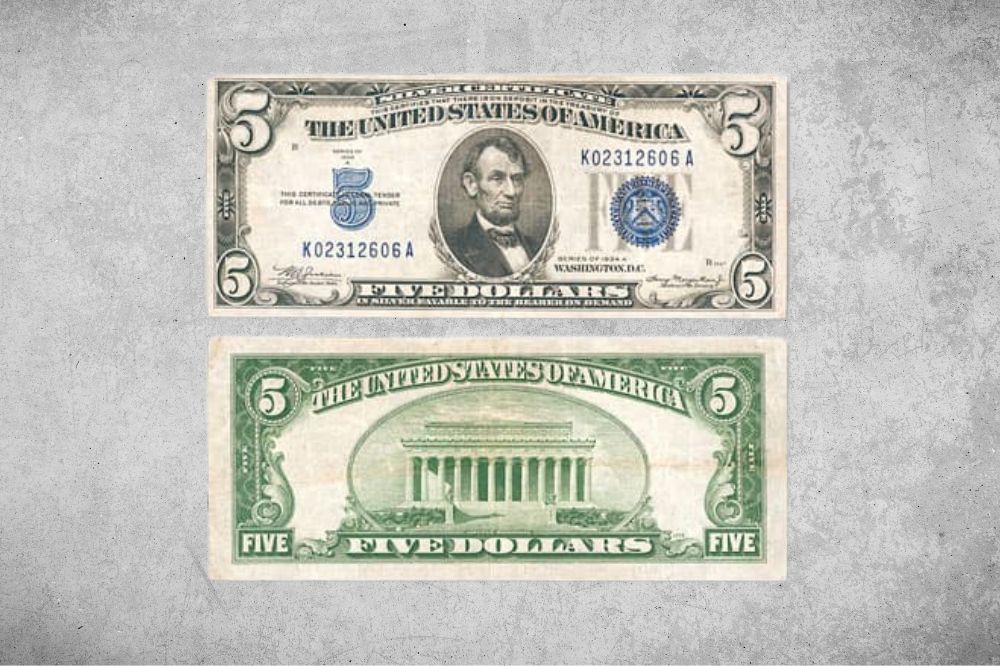The 1934 $5 dollar bill is commonly sought after by collectors and hobbyists, and this specific year carries many varieties and new features. On top of silver certificates, this year also printed unique North Africa and Hawaii notes to combat pre-WWII tension.
In addition to these basic, general differences, you may find 1934 $5 dollar bills with unique errors that make them more valuable. This is particularly common with silver certificates.
In this post, we discuss all the minor details you want to know about the 1934 $5 dollar bill varieties as well as the history of the bill and unique characteristics from this year.
Let’s begin!
1934 $5 Dollar Bill Details
- Category: $5 Silver Certificate; $5 Federal Reserve Note
- Series: 5 w/ blue seal; yellow seal; 5 w/ green seal; 2 w/ brown seal
- Producer: The Bureau of Engraving and Printing (BEP)
- Printing Place: Washington, D.C.
- Portrait: 16th American President, Abraham Lincoln
- Vignette: Lincoln Memorial
- Composition: 75% cotton; 25% linen
- Bill Dimensions: 2.60938 x 6.14061 inches (66.28 x 156 mm)
- Security Features: Raised texture and security fibers
Nineteen thirty-four was the first year that $5 silver certificates were printed small size, joining the $1 and $10 notes. This was also the year that the Treasury seal was moved to the right of the notes, so all series have them in the same position.
Five dollar silver certificates printed in 1934 have the same lathwork borders featured on the $10 silver certificate, and this was the only instance when different denominations used the same lathwork.
Beyond these changes (and apart from different seal colors), the 1934 $5 dollar bills have the same general appearance.
The front page features Lincoln’s portrait with seals to the right and serial numbers above the seal and below the blue $5 denomination on the left. The series is written above the denomination, then again to the right of Lincoln’s portrait.
The back has the Lincoln memorial as well as “FIVE DOLLARS” written below the building and “UNITED STATES OF AMERICA” along the upper edge.
Also Read: Top 21 Most Valuable 2000 P Sacagawea Dollar Coin Worth Money
Value Chart
1934 $5 Dollar Bill Value Chart (Silver Recyclers) |
|||||
| Series | Good | Fine | Extremely Fine | Uncirculated | Star (★) |
| 1934 A – D Blue Seal $5 Bill | $6 to $8 | $8 to $12 | $25 to $45 | $40 to $50 | $85 to $425 |
| 1934 A North Africa Yellow Seal $5 Bill | $10 to $25 | $25+ | $250+ | $300+ | $400 to $1,850 |
| 1934 A to D Green Seal $5 Bill | $5 to $8 | $8 to $10 | $10 to $30 | $30 to $50 | $125 to $225 |
| 1934 A Hawaii Brown Seal $5 Bill | $10 to $20 | $30 to $50 | $50+ | $250+ | $2,000 to $6,000 |
1934 $5 Dollar Bill Value and Series Guide
There were 4 different seals used for the 1934 $5 dollar bill, and within the blue and green seals there are 5 different series. This made for a particularly large array of $5 note varieties in 1935.
Apart from the seal, you can identify each bill by its signature combination.
- Henry Morgenthau, Jr. (Treasury Secretary) + William Alexander Julian (Treasurer): 1934 blue seal; 1934 A blue seal; 1934 A North Africa yellow seal; 1934 green seal; 1934 A green seal; 1934 brown seal; 1934 A Hawaii brown seal
- Frederick Moore Vinson (Treasury Secretary) + William Alexander Julian (Treasurer): 1934 B blue seal; 1934 B green seal
- John W. Snyder (Treasury Secretary) + William Alexander Julian (Treasurer): 1934 C blue seal; 1934 C green seal
- John W. Snyder (Treasury Secretary) + Georgia Neese Clark Gray (Treasurer): 1934 D blue seal; 1934 D green seal
Pay close attention to your note’s seal color and series; some have a much greater value than others, while more basic series are worth little more than face value.
1934 A – D $5 Dollar Bill (Blue Seal)
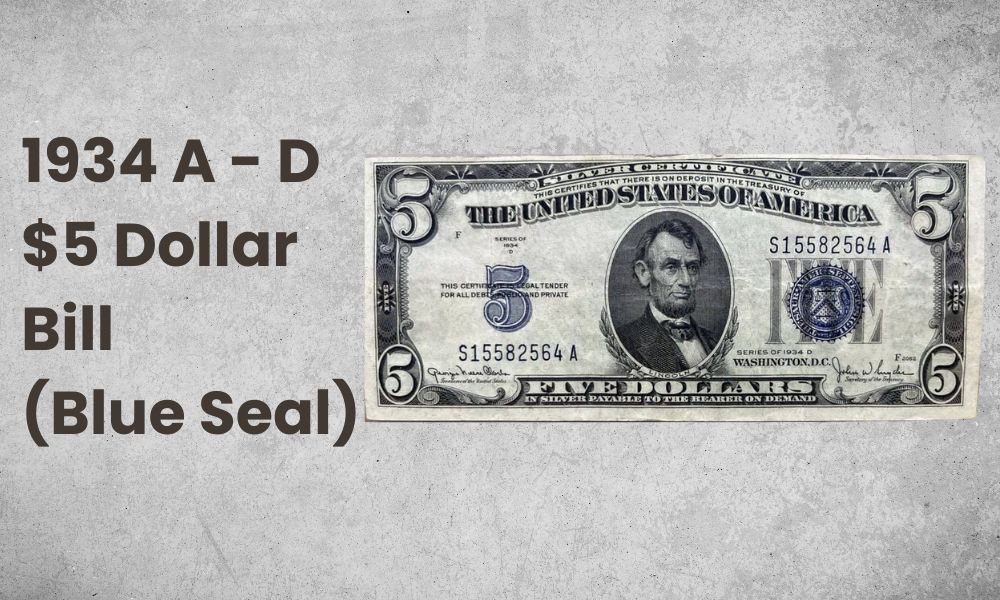
- Type: Silver Certificate
- Seal: Blue
- Year of Printing: 1934
- Face Value: $5.00
- $ Price: $6 to $50+
The blue seal is used to mark 1934 $5 dollar bills as silver certificates. These are inherently valuable because silver certificates are discontinued, but certain series are worth more than others.
1934 A had the largest run of any of these blue seal notes, and they’re worth a maximum $20 in most cases. 1934 B $5 silver certificates had the lowest run, and they can be worth north of $60 in uncirculated condition.
The C series has an unusually high number of star notes, making them particularly collectible. The 1934 D $5 silver certificates are moderately valuable, moreso than the A series but less than most B and C notes.
1934 A North Africa $5 Dollar Bill (Yellow Seal)
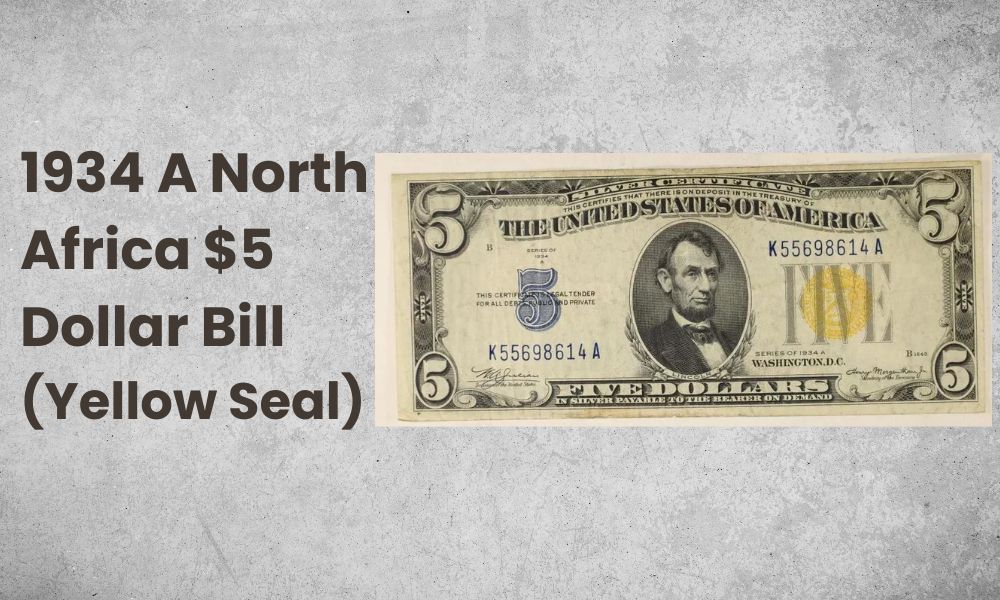
- Type: Silver Certificate
- Seal: Yellow
- Year of Printing: 1934
- Face Value: $5.00
- $ Price: $10 to $25+
The 1934 A North Africa $5 dollar bill is a silver certificate that was printed and used to pay U.S. military personnel stationed in North Africa during WWII. If Germans got a hold of the money, it could be immediately identified and devalued to prevent them from using it.
These $5 bills are relatively rare now, and the ones still around have been highly circulated. They start at $10 to $15 in good condition, but uncirculated bills are worth at least $250. Star notes easily start at $500, and many have gone for $1,850 or more when well-preserved.
1934 A – D $5 Dollar Bill (Green Seal)
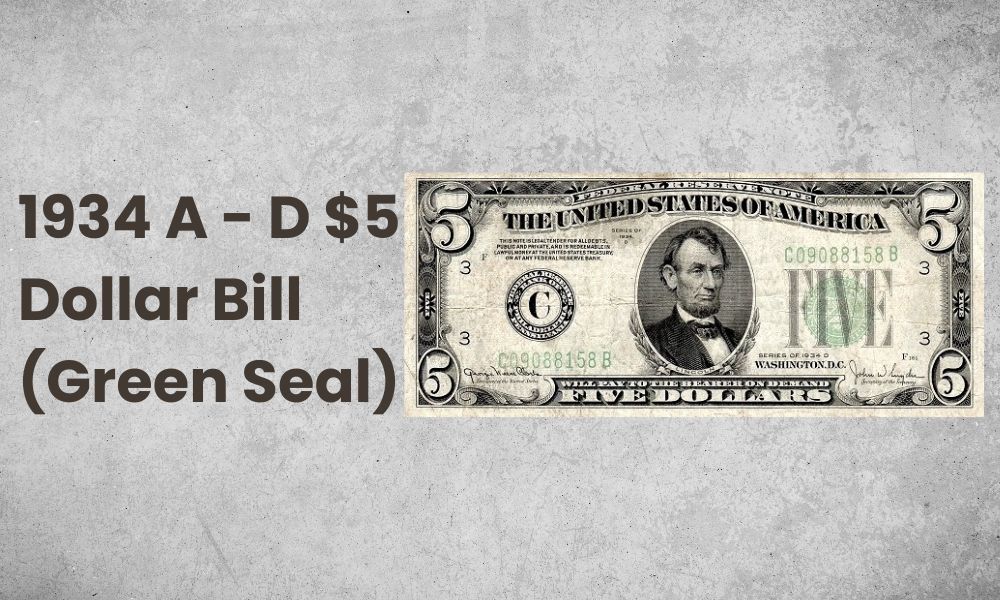
- Type: Federal Reserve Note
- Seal: Green
- Year of Printing: 1934
- Face Value: $5.00
- $ Price: $5 to $30+
Green seal 1934 $5 dollar bills are not worth as much as their blue seal cousins, but you may still find valuable paper of this variety.
In perfect condition, a green seal 1934 $5 bill may be worth $30 to $50, while high grade star notes are easily worth $125 to $225 and more.
1934 A Hawaii $5 Dollar Bill (Brown Seal)
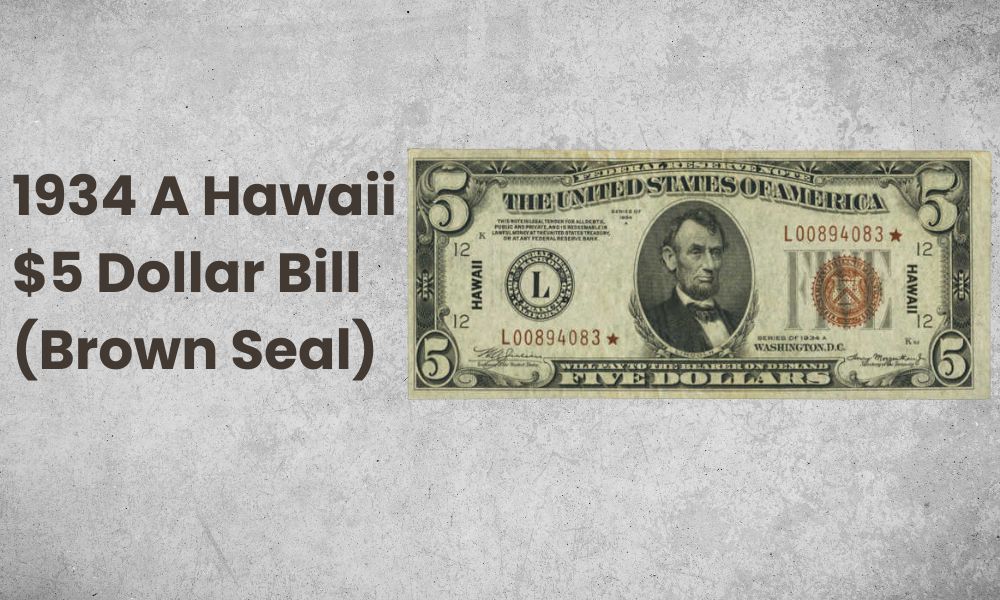
- Type: Federal Reserve Note
- Seal: Brown
- Year of Printing: 1934
- Face Value: $5.00
- $ Price: $30 to $250+
The brown seal on the Hawaii Federal Reserve notes serve a similar purpose as the North Africa notes. These bills were printed to pay troops stationed in Hawaii at the time in case Japan forces stole the money.
On top of the right seal to the right of the portrait, Hawaii notes feature the word “HAWAII” overprinted in brown on the verse.
The regular series of these notes are more rare than silver certificates, but less so than North Africa notes. In extremely fine or uncirculated condition, they may be worth $50 to $250 or more.
Star notes of the brown seal Hawaii bills are exceptionally rare, and easily worth $2,000 to $6,000 or more.
1934 $5 Dollar Bill History
The 1934 $5 dollar bill has a history that mixes tradition with change.
One one hand, these bills are standards of their time. Silver certificates and federal reserve notes were both in circulation, and the blue seal notes would not be discontinued until 1963.
The Federal Reserve notes we see from 1934 are similar to the ones that exist today. The model was first introduced in 1914, and it has gone through several security transformations since then to stay ahead of counterfeiters.
Some distinguishable features of the 1934 $5 bill relate to international tension at the time.
While WWII had not yet started, the Nazi party had assumed power in Germany the year prior, and Hitler would become Führer of Germany later in the year. Japan and Germany were already allied, and the world was watching.
The United States decided to print special seals for paper currency used to pay troops stationed close to the conflict. This resulted in the Yellow and Brown seals you see on certain notes, and these are particularly sought after for collections.
1934 $5 Dollar Bill Grading
Most numismatists, if not all, refer to the PMG grading scale for paper currency. This is a 70 point grading scale, based on the Sheldon Scale, to determine note condition, but it is only valid if graded by a professional.
Despite that, you can still determine a basic condition for your 1934 $5 dollar bill based on your own observations. This can help you generate an estimated value, or help you weed out bills you may or may not want to pursue for your collection.
Good
Good bills show obvious signs of circulation.
On the poorer end, they may have obvious soiling and considerable wear. These bills may be missing their corners.
On the finer side, these notes are not as dirty but still show creases, folds, or wrinkles. Their corners may be worn and rounded, and they may have some tears, but the note should be wholly intact.
Fine
To be considered fine, paper should have no tears on edges and retain at least some of its crispness.
These bills may not have sharp edges, and they may have folds, dirt, or smudging. Fine bills may also have some obvious fading, but they’re definitely a step up from good bills.
Extremely Fine
Extremely fine bills are as close to uncirculated as you can get. Paper should retain its original sheen with clean, bright coloring. While you may detect some light folds or a single, strong crease, these bills are mostly untouched.
Extremely fine bills should be without tears and stains. Finer paper may appear uncirculated at first but can still show light signs of handling like slight finger smudges or minor corner folds.
Uncirculated
Uncirculated paper currency was not released into circulation, and it is in similar condition to when it was first printed. Paper should have its original firmness and crispness, with absolutely no folds, creases, or tears.
Uncirculated 1934 $5 dollar bills have sharp, square corners.
Star (★)
While star notes are not directly related to paper currency grading, and you can have different grades of a star note, they have an immediate effect on the value of the note.
Star notes were replacement paper that the BEP used to replace misprints or damaged currency before its release. They’re exactly the same as the original note in the series, but have a star printed at the end of the serial number (beginning for silver certificates).
Star notes are inherently rare, making them a well-sought after variety for any collection. A star may instantly double the highest value of the note.
List of 1934 $5 Dollar Bill Errors
The 1934 $5 dollar bill doesn’t have any well-recognized errors like other years may have, but its period of printing was particularly prone to errors. If you find a bill with any of these errors, you’re holding onto a more valuable note.
The most common include:
- Inverted serial numbers or overprints
- Serial number misprints like stuck digits or mismatched serial numbers.
- Overprints such as seals, district numbers, and serial numbers on the reverse
- Double/ misplaced seals
- Gutter folds from uncut sheets sent through with a wrinkle in the paper (possibly multiple wrinkles)
- Miscut bills from faulty alignment; may be minor or major
- Off-center prints
The 1934 D Federal Reserve note in this video features a double denomination, making it an exceptionally rare specimen. Make sure you have proper authentication of these bills before you get too excited.
1934 $5 Dollar Bill FAQs
What is the Value of a 1934 $5 Dollar Bill?
While there are five different series of the $5 dollar bill from 1934, most well-preserved banknotes are only worth $8 to $12. Rare 1934 $5 bills, mainly rare seals, errors, and star notes, can be worth $45 or more depending on the market and paper condition.
How Much is a 1934 $5 Bill with a Blue Seal Worth?
A 1934 $5 bill with a blue a blue seal is worth at least $6 per note, with more excellent notes worth at least $8 to $12 and beyond. The blue seal identifies them as five-dollar silver certificates (which are now discontinued and collectible), distinguishing them from the green seal Federal Reserve notes from the same year.
What Makes a 1934 $5 Bill rare?
The 1934 $5 bill is not the most rare paper currency out there, but it has several collectible and desirable collections. This year they released several silver certificates (which are now discontinued), and WWII notes like the 1934A Hawaii Federal Reserve notes are much more limited (and, therefore, rare).
